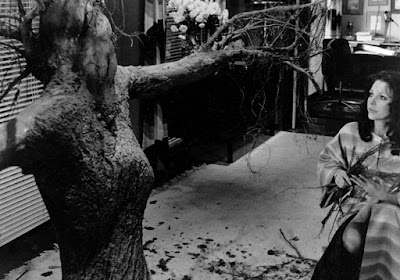"Does anyone here love me?" Joan Collins in Mel, where her husband's attentions shift to a tree which he sculpts into the female form.
OFTEN mistaken for an Amicus portmanteau, possibly because of the contemporary setting, this Freddie Francis-helmed anthology was actually made by World Film Services. TALES THAT WITNESS MADNESS was inspired by Amicus' ASYLUM released the previous year, not least because of its mental patient setting, but also by its general outlandishness. Psychiatrist Dr Tremayne (Donald Pleasence) relates four cases to Dr Nicholas (Jack Hawkins, dubbed by Charles Grey): in Mr Tiger, introverted boy Paul (Russell Lewis) confides with an "imaginary" tiger against a backdrop of warring parents; an inherited Penny Farthing causes trouble for antique dealer Timothy (Peter McEnery) and girlfriend Ann (Suzy Kendall); Mel is a piece of tree art that starts frictions between husband and wife Brian (Michael Jayston) and Bella (Joan Collins); and Luau tells of human sacrifice involving literary agent Auriol (Kim Novak) and her daughter Ginny (Mary Tamm), where the latter is consumed to appease an Hawaiian god.
Based on short stories by actress Jennifer Jayne (credited here as Jay Fairbank) - who played Donald Sutherland's vampire bride in DR TERROR'S HOUSE OF HORRORS - TALES THAT WITNESS MADNESS is as literal and silly as most of the Amicus product, but elevated to watchable status by its cast (save for Novak who broke a four year hiatus to overplay her highly unlikable character after replacing Rita Hayworth). Jayston and Collins are particularly in tune to their slice of camp nonsense, Bella understandably annoyed not just because of her husbands wandering eye, but also because Mel - the name carved into its trunk - is damaging her cream shag pile carpet. If there is any overall underlying trend, it is a festering resentment with domesticity and the routine of married/working life.
In what is potentially the most interesting tale, Suzy Kendall encounters a haunted portrait and a time-distorting Penny Farthing.
Similar to the unevenness inherent in comedy sketch shows, the anthology subgenre is noted for its varied quality. As Mark Gatiss stated in BBC4's A HISTORY OF HORROR, it is fun to piece together your favourite portmanteau stories into a single outing; Mel could provide the icing on the cake to the wackiest, perhaps together with the reptile sequence from SECRETS OF SEX, the vampire film producer storyline from THE MONSTER CLUB, and the killer piano from TORTURE GARDEN. Yet the origins of the multi-tale film are held in much higher esteem, taking a cue from the episodic structure of Gothic novels The Monk and Melmoth the Wanderer (1876 and 1878 respectively). In fact, it was German silent cinema which first embraced the notion with Richard Oswald's EERIE TALES, Fritz Lang's DESTINY and Paul Leni's WAXWORKS. DESTINY, in particular, opens up The Grim Reaper as a leading character, omnipresent force and deadly puppet master.


